This article was published in Scientific American’s former blog network and reflects the views of the author, not necessarily those of Scientific American
Today sees the publication of a significant new technical paper on dinosaur phylogeny. And it’s a game-changer or watershed study, one of those that will get cited a phenomenal amount and result in a distinct pre- and post-2017 marker in the literature. The paper concerned – published in Nature and authored by Matthew Baron, David Norman and Paul Barrett – argues that the consensus view of dinosaur phylogeny is inaccurate, that Saurischia of convention (the sauropodomorph + theropod clade) is not monophyletic, and that theropods are closer to ornithischians than they are to sauropodomorphs (Baron et al. 2017). This is surprising stuff in view of the apparently robust, conventional and well-supported view that Saurischia of traditional is natural, a hypothesis that has been well bolstered by substantial study and the gradual accruing of data.
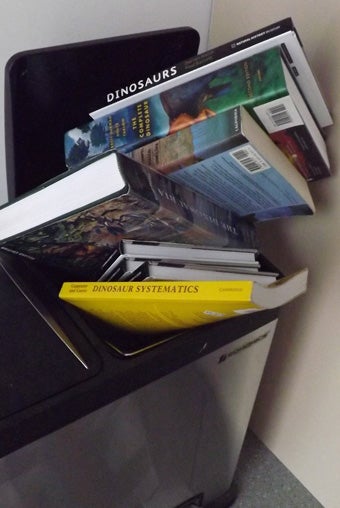
A perfectly normal and standard response to the busting of a paradigm. Credit: Darren Naish
First things first: science is about scepticism, and no hypothesis is ever a definitive ‘last word’ on a subject. While the model proposed here looks good – good enough that it appears to represent reality – it’s only as good as the data available right now, and at this early stage it’s impossible to predict whether this novel model will survive to eternity. I don’t say that to put a downer on the study but to remind people not to complain too much when cherished hypotheses are overturned or found wanting.
On supporting science journalism
If you're enjoying this article, consider supporting our award-winning journalism by subscribing. By purchasing a subscription you are helping to ensure the future of impactful stories about the discoveries and ideas shaping our world today.
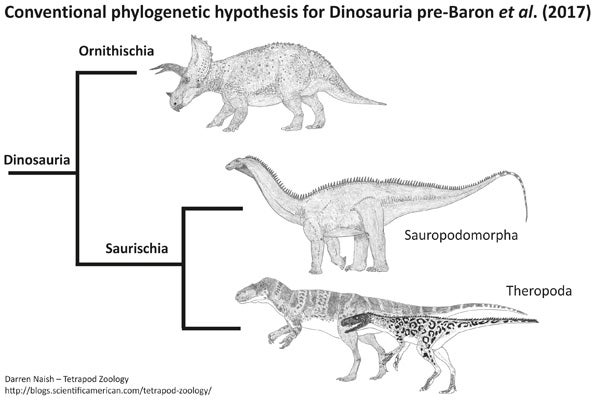
A dinosaur phylogeny of the sort that would be considered conventional. Herrerasaurids are regarded as part of Theropoda within this hypothesis. Credit: Darren Naish
Baron et al. (2017) list a set of features that link ornithischians and theropods to the exclusion of sauropodomorphs and herrerasaurs. There are a surprising number of them and they occur across the skeleton. The characters emphasise detailed overall similarity between early ornithischians and theropods but also highlight the fact that previous authors – many of whom had noted the same features – had been interpreting these same traits as ancestral dinosaur features and downplaying or ignoring the possibility that they might be indicative of a different phylogenetic pattern. There’s a lesson there. The term Ornithoscelida is suggested for this group: this name was coined by Huxley in 1870 for a group erected for dinosaurs before there was a concept of a distinct Sauropodomorpha* (Huxley 1870, Baron et al. 2017). The authors retain Saurischia for the sauropodomorph + herrerasaur clade.
* Text corrected: I originally said that Ornithoscelida was erected for a group that “included various ornithischian and theropod taxa but no sauropodomorphs”, but that’s not correct (see comments). Thanks to M. Mortimer.
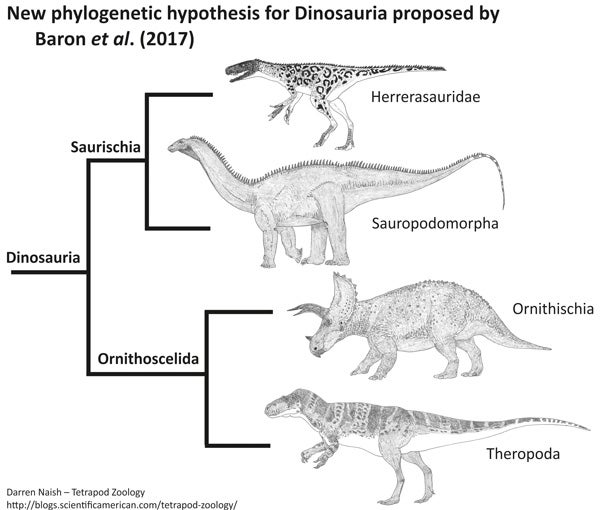
The Baron et al. (2017) hypothesis. Credit: Darren Naish
First of all, I’m glad, since I really hate describing the saurischian-ornithischian dichotomy in my popular writing. It’s confusing and misleading (“ornithischians have bird-like hips, except for some that might not, and some saurischians – which are called lizard-hipped dinosaurs, even though their hips don’t look like those of lizards – also have bird-like hips, most notably birds, which are bird-hipped saurischians even though they aren’t bird-hipped dinosaurs, although they actually are”) and I’m pleased to see that it might not be needed anymore. More seriously…
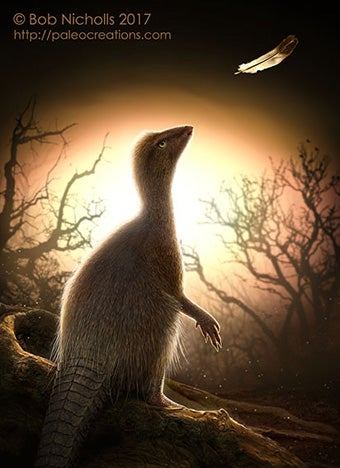
Cover of the current edition of Nature. The fuzzy ornithischian Kulindadromeus looks up at a theropod feather. Credit: Bob Nicholls
Wasn’t this always obvious? (no, no it wasn’t). At the risk of sounding like someone who says “oh ho ho, we knew this all along” (no we didn’t), this study perhaps isn’t the surprise it might have been a decade or two ago. Early-diverging ornithischians – heterodontosaurids in particular – have been looking vaguely theropod-like for a while now, and indeed the early members of all three major dinosaur clades are enough alike to suggest that things could go any number of ways. The discovery of the early ornithischian Eocursor in 2007 led to comments about its vaguely theropod-like demeanour, Eoraptor has bounced around between Theropoda and Sauropodomorpha, and I recall thinking at the time of its publication (2011) that long-toothed weirdo theropod Daemonosaurus does not look a million miles away from a heterodontosaurid.
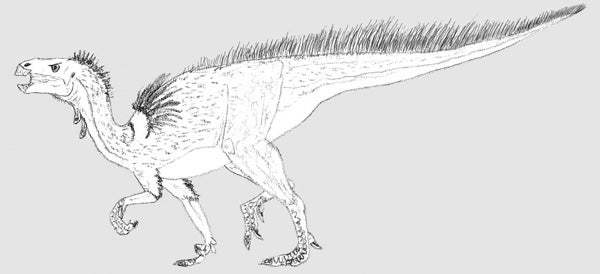
A very dated, old reconstruction of a heterodontosaurid in an incorrect quadrupedal posture, based on illustrations by Greg Paul. It has something of a theropod feel about it -- hey, maybe this is now totally ok and actually correct. Credit: Darren Naish
Remember also that the notion of Phytodinosauria (a proposed ornithischian-sauropodomorph clade) – pushed during the 1980s by Bakker and Paul and supported by Paul Sereno at one point – was never especially radical, it just hasn’t proved well supported.
For all these platitudes, however, the point remains that the hypothesis and new data presented by Baron et al. (2017) primarily evidences how a non-biased approach and the careful and thorough collection and analysis of a ton of new data can overturn a conventional hypothesis. Let me emphasise that: this study comes as the result of the careful and thorough collection and analysis of a ton of new data.
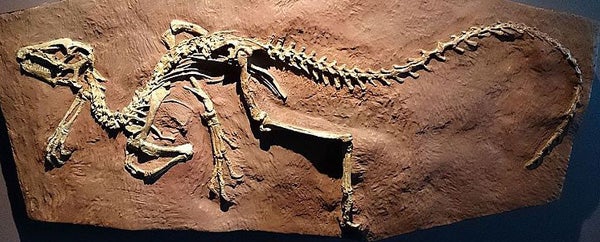
Early ornithischians (like this Heterodontosaurus) share with early theropods a diastema in the upper jaw, a ridge on the maxilla and nearly 20 other characters. The list is pretty impressive. Credit: Nkansahrexford Wikimedia(CC BY 3.0)
Some implications. There’s a lot that could be said about this model and what it might mean for dinosaur evolution, but let’s look briefly at a few things that immediately spring to mind.
If sauropodomorphs and herrerasaurs are outside Ornithoscelida, it follows that they lack features common to members of that latter group. Today we know that both ornithischians and theropods (of at least some lineages) possessed hair-like or quill-like integumentary structures, whereas the absence (thus far!) of such structures from sauropodomorphs is slightly suspicious. Ok, that absence may be more to do with the quirks of the fossil record than anything else, but could it be that key events in integumentary evolution occurred in the ornithoscelidan common ancestor, not the dinosaurian one? In other words, might it be that the sauropodomorph + herrerasaur clade never possessed such structures? One good fossil could resolve this, and let’s not forget – as if – that the presence of integumentary fibres in pterosaurs provides support for a fuzzy dinosaurian common ancestor.
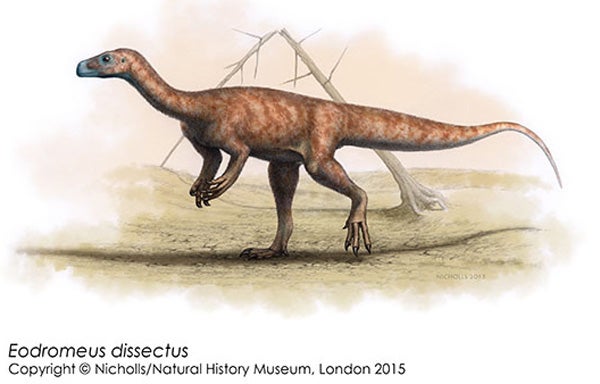
It's still controversial as to whether the earliest theropods (like Eodromaeus) were fuzzy. We decided to go for fuzz in this reconstruction, by Bob Nicholls. Was this true for early sauropodomorphs and other saurischians too? More data needed! Credit: Bob Nicholls, Naish & Barrett 2016
The proposed monophyly of Ornithoscelida also makes something else even weirder than it was before, and this is the lack of skeletal pneumaticity in ornithischians. Models where Saurischia of tradition is monophyletic make it seem reasonable to think that dinosaurs were apneumatic ancestrally, and that skeletal pneumaticity then evolved as a novelty in the sauropodomorph-theropod common ancestor (though this is a gross simplification for reasons I don’t have time to go into here).
But with ornithischians sandwiched between these two pneumatic lineages (Baron et al. 2017)… ugh. Did skeletal pneumaticity evolve independently in the sauropodomorph and theropod lineages, was skeletal pneumaticity ancestrally widespread and then lost in ornithischians, or are there pneumatic ornithischians out there that we’ve missed, in part due to our expectation that they weren’t pneumatic? None of these are new questions, but we’ll now see them get asked a lot more. There have been one or two claims of skeletal pneumaticity in ornithischians – I wrote about the case of the iguanodontian Delapparentiahere, back in 2011 (and see Ruiz-Omeñaca 2011) – but they’re generally regarded as erroneous or unconvincing (Wedel & Taylor 2013). Keep looking for evidence for skeletal pneumaticity in ornithischians – it may well be out there, and note that skeletal pneumaticity in some early sauropodomorph lineages was missed for decades.
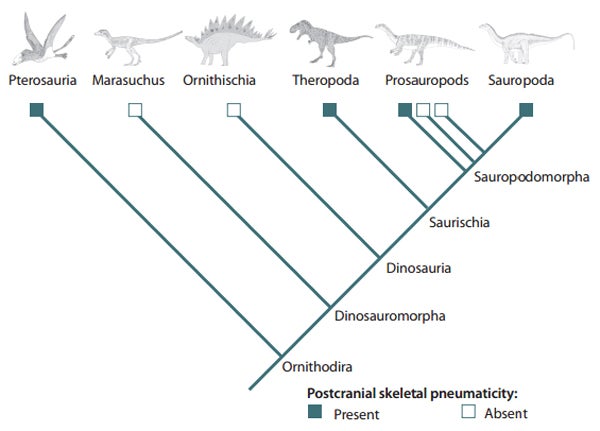
Ornithodiran skeletal pneumaticy as depicted by Naish & Barrett (2016). The hypothesis of an ornithoscelidan clade changes things somewhat. Credit: Naish & Barrett 2016
While there’s much more that could be said (herrerasaur-theropod convergence, generalist omnivory for the dinosaur common ancestor, a Laurasian setting for dinosaurian origins...), that will do for now. An illustration above makes the half-serious point that artistic reconstructions of early-diverging ornithischians are now ‘allowed’ to look more theropod-like than was the case before, but this is actually something we should now consider seriously: if ornithischians and theropods really are close kin, they should share more specific features of biology and anatomy than was thought likely before.
One last thing… that dinosaur book Paul Barrett and I published last year (Dinosaurs: How They Lived and Evolved) is now looking oh so dated already.
For other recent Tet Zoo articles on Mesozoic dinosaurs, see...
Refs - -
Baron, M. G., Norman, D. B. & Barrett, P. M. 2017. A new hypothesis of dinosaur relationships and early dinosaur evolution. Nature doi:10.1038/nature21700
Huxley, T. H. 1870. On the classification of the Dinosauria, with observations on the Dinosauria of the Trias. Quarterly Journal of the Geological Society, London 26, 32-51.
Ruiz-Omeñaca, J. I. 2011. Delapparentia turolensis nov. gen et sp., un nuevo dinosaurio iguanodontoideo (Ornithischia: Ornithopoda) en el Cretácico Inferior de Galve. Estudios Geológicos 67 doi: 10.3989/egeol.40276.124